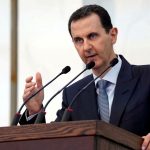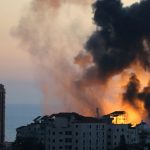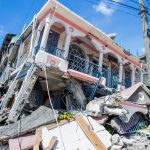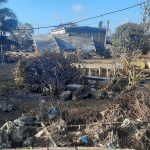The Ukrainian president has called a Russian airstrike on a children’s hospital an “atrocity”, as he repeated his call for the West to implement a no-fly zone.
Here are the other key updates from the region:
• Efforts to evacuate civilians through safe passages were again under way
• Despite heavy fighting nearby, the capital Kyiv remains under Ukrainian control
• A number of cities have been under heavy Russian shelling, while others are preparing to face attacks
This map shows the current situation in Ukraine.
The east
Mariupol city council reported that Russian forces “have dropped several bombs” on a children’s hospital.
“The destruction is colossal,” a spokesperson said.
Shortly after the attack, President Volodymyr Zelenskyy tweeted: “Direct strike of Russian troops at the maternity hospital. People, children are under the wreckage. Atrocity!”
He issued another call to the West to implement a no-fly zone over Ukraine.
Mariupol. Direct strike of Russian troops at the maternity hospital. People, children are under the wreckage. Atrocity! How much longer will the world be an accomplice ignoring terror? Close the sky right now! Stop the killings! You have power but you seem to be losing humanity. pic.twitter.com/FoaNdbKH5k
Mariupol has been surrounded by Russian forces for more than a week, with reports that people there are now having to scavenge for food and melt snow for water.
Attempts to evacuate people from the Black Sea port city have repeatedly faltered over the past few days.
The humanitarian situation
Mariupol was one of six places that was meant to have seen the establishment of a “humanitarian corridor” to get civilians out.
The routes announced by Ukraine today were:
• Mariupol (south) to Zaporizhzhia (southeast)
• Enerhodar (southeast) to Zaporizhzhia
• Sumy (northeast) to Poltava (central)
• Izyum (east) to Lozova (east)
• Volnovakha (east) to Pokrovsk (east)
• And from several towns around Kyiv including Vorzel, Borodyanka, Bucha, Irpin and Hostomel to the capital
A ceasefire was announced in the areas between 9am and 9pm local time.
In the afternoon, Ukrainian interior ministry adviser Vadym Denysenko said Moscow had “largely failed” to adhere to these agreements.
Despite this, a number of the corridors appear to have been used today, including in Enerhodar and in parts of Kyiv.
Attempts to move people to areas of safety have been tried before today, but they largely failed.
Tuesday saw the first real success for the humanitarian corridors, with about 7,000 people managing to leave the northern city of Sumy. Evacuations from there continued today.
More than 2.2 million people have left Ukraine, with 1.3 million going to Poland alone. The UK government has been criticised after so far only issuing 700 visas to Ukrainian refugees.
The battle for Kyiv
The capital city of Kyiv remains under Ukrainian control despite fighting in areas nearby.
A convoy of Russian military vehicles spread out along a 40-mile stretch of road has now been stuck outside the capital for more than a week, with Moscow meanwhile putting resources into attacking areas east of Kyiv.
Air Marshal Edward Stringer, former director general of Future Force Development, told Sky News it “increasingly looks like the Russian’s have created their own 40-mile road block”.
He added: “[Russia] are trying to double down and come up with a plan B when they didn’t have one – and that looks like its increasingly putting pressure on Kyiv to try and reach some form of acceptable solution.”
Fighting is also continuing in the northwest of the region, including in Irpin.
People attempting to leave the city, on the outskirts of Kyiv, have been crossing the damaged bridge visible in this satellite image.
In Kyiv itself, in an act of defiance, an orchestra assembled to play the national anthem and other songs to a small crowd.
The south
Kherson remains the only city under Russian control, with locals protesting against the occupation.
Russia’s National Guard announced today it had detained more than 400 protesters in the area.
Residents of Odesa are preparing to defend the key port and tourist city, draping a giant blue and yellow banner reading “Odesa-Ukraine” over sandbags in front of the Opera and Ballet Theatre in the near-deserted city centre.
Meanwhile, Ukraine’s armed forces say Russians dressed in civilian clothes are advancing on the nearby city of Mykolaiv.
What’s happened so far?
– Day 1: Russia launches full-scale invasion
– Day 2: Russian forces reach Kyiv
– Day 3: Ukraine fights back in Kyiv, Russia gain in the south
– Day 4: Kyiv holds strong, heavy fighting in Kharkiv
– Day 5: Convoy grows around Kyiv as refugees flee
– Day 6: Cluster bombs hit Kharkiv
– Day 7: Civilian casualties mount
– Day 8: Mariupol is isolated as Russian forces create land bridge
– Day 9: Russian forces target Europe’s largest nuclear power plant
– Day 10: Ceasefire violated in Mariupol as bombing continues
– Day 11: Russia prepares Kyiv for advance and how energy could be a key battle
– Day 12: More humanitarian routes opened as bombing continues in Kyiv suburbs
– Day 13: Civilians successfully evacuated – but has Russian advance stalled?
Sky News is using daily assessments published by the Institute for the Study of War and AEI’s Critical Threats Project to indicate which parts of Ukraine are under control by Russian troops.
From 2 March, these daily assessments distinguished between areas of Ukraine controlled by Russia and areas of assessed Russian advances (where Russian troops are believed to be operating but not in control).
Other sources for Russian advances include the UK Ministry of Defence.
Sky News is verifying all social media videos and stills before use.
The War in Ukraine is a rapidly developing story. While we endeavour to keep all our data and maps up to date, there might be times when the latest changes have not yet been reflected in the maps.
The Data and Forensics team is a multi-skilled unit dedicated to providing transparent journalism from Sky News. We gather, analyse and visualise data to tell data-driven stories. We combine traditional reporting skills with advanced analysis of satellite images, social media and other open source information. Through multimedia storytelling we aim to better explain the world while also showing how our journalism is done.






















